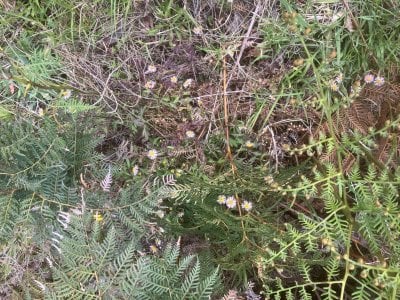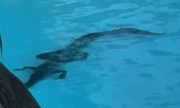Shocking photo ignites fear of Aussie invasion: The looming threat you need to know about NOW!
- Replies 36
The picturesque landscapes of Australia are often adorned with a myriad of vibrant flora that not only add to the natural beauty but also support a diverse ecosystem.
However, a recent photograph taken along a coastal road has sparked a significant warning about an invasive threat that could disrupt this delicate balance.
The image, showcasing pink flowers scattered along the roadside and down several tracks in Lorne, a town on the iconic Great Ocean Road in Victoria, was captured by wildlife ranger Kim Hammond.
While at first glance, these blooms might seem like a charming addition to the scenery, their presence has raised serious concerns among environmental authorities.
These seemingly innocent seaside daisies, as they are known, are far from benign. In fact, they represent a formidable invasive species that can rapidly spread and cause extensive damage to native vegetation, which is crucial for the survival of local birds and animals.

Kim Hammond, from the Great Ocean Road Coast & Parks Authority (GORCPA), has been vocal about the urgency of addressing this issue.
'These flowers produce masses of seeds that are easily spread by the wind and water, posing a serious issue in coastal areas like the Great Ocean Road if not controlled early,' she explained.
GORCPA stated that it is ‘important’ that the weeds, which come from the West Coast of the United States, should be removed from backyards or public spaces.
The spread of seaside daisies is not just an environmental concern but also a stark reminder of the fragility of our ecosystems and the need for vigilance in preserving them.
The warning has resonated with the public, as one Geelong resident admitted to ‘just planted some in my garden’, mistaking them for native plants.
This is a common error, even among the most diligent gardeners, and highlights the need for greater awareness and education regarding invasive species.
‘It's a common garden plant, so plenty of keen green thumbs wouldn't realise that seaside daisies are a significant environmental weed,’ Hammond explained.
She also expressed her personal opinion that the weed ‘isn't very attractive’, which may come as a surprise to those who have been charmed by its vibrant colour.
The invasive species thrives in moist soil and is adept at spreading via wind and water, making Australia's coastal regions particularly vulnerable to its proliferation.
However, there is hope for those who wish to contribute positively to their local environment.
‘Fortunately, there are plenty of great alternatives that won’t get out of control and harm our local environment. I encourage people to talk to your local nursery for ideas and advice on suitable plants to grow like native daisies,’ Hammond suggested.
A recent roadside photo has sparked significant concern over an invasive threat spreading across Australia, highlighting the urgent need for vigilance in managing these environmental hazards.
This warning resonates strongly with recent council alerts about hidden dangers lurking in common garden flowers, underscoring the importance of being aware of and addressing these silent threats in our own backyards.
 We urge you to take this warning seriously and review your own gardens for the presence of seaside daisies or other invasive species. Consult with local nurseries and gardening experts to find native alternatives that will flourish without endangering the natural landscape.
We urge you to take this warning seriously and review your own gardens for the presence of seaside daisies or other invasive species. Consult with local nurseries and gardening experts to find native alternatives that will flourish without endangering the natural landscape.
Have you encountered invasive plants in your garden or local area? What steps have you taken to address the issue? Share your stories and tips with us in the comments below. Together, we can protect the natural heritage of our beautiful country for future generations to enjoy.
However, a recent photograph taken along a coastal road has sparked a significant warning about an invasive threat that could disrupt this delicate balance.
The image, showcasing pink flowers scattered along the roadside and down several tracks in Lorne, a town on the iconic Great Ocean Road in Victoria, was captured by wildlife ranger Kim Hammond.
While at first glance, these blooms might seem like a charming addition to the scenery, their presence has raised serious concerns among environmental authorities.
These seemingly innocent seaside daisies, as they are known, are far from benign. In fact, they represent a formidable invasive species that can rapidly spread and cause extensive damage to native vegetation, which is crucial for the survival of local birds and animals.

Wildlife ranger Kim Hammond found invasive seaside daisies along a Lorne road in Victoria, prompting an urgent warning about their spread. Credit: Facebook / Great Ocean Road Coast and Parks Authority
Kim Hammond, from the Great Ocean Road Coast & Parks Authority (GORCPA), has been vocal about the urgency of addressing this issue.
'These flowers produce masses of seeds that are easily spread by the wind and water, posing a serious issue in coastal areas like the Great Ocean Road if not controlled early,' she explained.
GORCPA stated that it is ‘important’ that the weeds, which come from the West Coast of the United States, should be removed from backyards or public spaces.
The spread of seaside daisies is not just an environmental concern but also a stark reminder of the fragility of our ecosystems and the need for vigilance in preserving them.
The warning has resonated with the public, as one Geelong resident admitted to ‘just planted some in my garden’, mistaking them for native plants.
This is a common error, even among the most diligent gardeners, and highlights the need for greater awareness and education regarding invasive species.
‘It's a common garden plant, so plenty of keen green thumbs wouldn't realise that seaside daisies are a significant environmental weed,’ Hammond explained.
She also expressed her personal opinion that the weed ‘isn't very attractive’, which may come as a surprise to those who have been charmed by its vibrant colour.
The invasive species thrives in moist soil and is adept at spreading via wind and water, making Australia's coastal regions particularly vulnerable to its proliferation.
However, there is hope for those who wish to contribute positively to their local environment.
‘Fortunately, there are plenty of great alternatives that won’t get out of control and harm our local environment. I encourage people to talk to your local nursery for ideas and advice on suitable plants to grow like native daisies,’ Hammond suggested.
A recent roadside photo has sparked significant concern over an invasive threat spreading across Australia, highlighting the urgent need for vigilance in managing these environmental hazards.
This warning resonates strongly with recent council alerts about hidden dangers lurking in common garden flowers, underscoring the importance of being aware of and addressing these silent threats in our own backyards.
Key Takeaways
- Wildlife ranger Kim Hammond discovered invasive seaside daisies along a road in Lorne, Victoria, prompting an urgent warning about their spread.
- Seaside daisies are an invasive weed from the West Coast of the United States that threaten native vegetation and wildlife food sources.
- Authorities from the GORCPA stress the importance of removing these weeds to prevent further damage to coastal ecosystems.
- Residents are urged to choose native plants over invasive species and to seek advice from local nurseries for suitable gardening alternatives.
Have you encountered invasive plants in your garden or local area? What steps have you taken to address the issue? Share your stories and tips with us in the comments below. Together, we can protect the natural heritage of our beautiful country for future generations to enjoy.







